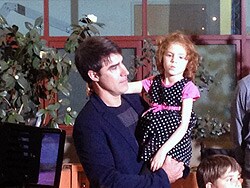Polio-Like Syndrome Surfaces in California
Reports of a puzzling polio-like syndrome affecting children in northern California have launched something of media frenzy.
Emmanuelle Waubant, MD, PhD, professor, clinical neurology and pediatrics, University of California at San Francisco (UCSF), said she was surprised by all the attention to this case series, and believes it's because the cases are linked to "children" and "polio," 2 words that set off alarms when used together.
To date, Dr. Waubant and her colleagues have identified 5 children, aged 2 to 16 years, who presented with acute onset of flaccid paralysis affecting 1 or more limbs that reached peak severity within 48 hours of onset. MRI showed nonenhancing T2 hyperintensities of the central gray matter; cerebral spinal fluid was normal, albeit mildly pleocytotic.
The cases will be presented at the upcoming 66th Annual Meeting of the American Academy of Neurology (AAN) in Philadelphia, April 26 to May 3.
Doctors initially suspected transverse myelitis, an inflammation of the spinal cord that may cause paralysis, but lack of sensory changes and other telltale neurologic symptoms, plus a negative workup, ruled out this diagnosis, said Dr. Waubant. They also excluded Guillain-Barré syndrome and botulism.
 |
Jeff Jarvis of Berkeley, Calif., holds his 4-year-old daughter, Sofia Jarvis, during a news conference at Lucille Packard Children's Hospital at Stanford University on Feb. 24, 2014. Sofia is one of a handful of California children who has been diagnosed with a rare polio-like syndrome that has left her arm paralyzed. AP Photo/Martha Mendoza |
Three of the youngsters had prodromal respiratory illness before their paralysis, which, said Dr. Waubant, "is probably significant." Poliovirus has been eradicated from most of the globe, but other viruses can also injure the lower motor neurons of the spine, leading to a polio-like syndrome.
So far, 2 cases have tested positive for the enterovirus-68, a rare virus that in the past has been associated with polio-like syndrome.
"In the case of an enterovirus, you can have a cold-like presentation," said Dr. Waubant. "We think that if it's a virus [responsible for the symptoms presented], it's probably a virus that is not responsible for paralysis in every single patient that is affected, only in specific patients that have the right biological makeup."
Children Vaccinated
Although the disorder "looks clinically like polio," polio itself was also ruled out because all the children had been vaccinated against the polio virus. "All the cases had a good level of antibodies so they could not be infected with the polio virus," said Dr. Waubant.
There's nothing really to tie these children together except for their clinical presentation. "They had nothing in common," said Dr. Waubant. "It's not a cluster because they came from different areas," although they were from within a 100-mile radius of each other in northern California.
Treatment with steroids, intravenous immunoglobulin, and/or plasma exchange did not appear to have a clinical benefit, with motor function recovery at 6 months described as being poor. "The children have remained quite disabled," she said. "Some have recovered a little bit but the improvement has been from zero to marginal."
Similar cases have been reported in Australia and Asia, and there are likely more cases across the United States, said Dr. Waubant. Other reports have identified about 20 cases so far in the United States, all in California.
"There are always outbreaks of new viruses or viruses that have mutated from old types of viruses," she noted, adding that these often disproportionately affect children because they have not built up immunity to similar viruses.
These new California cases may not have been linked at all had it not been for 2 curious researchers: Dr. Waubant at UCSF and Keith Van Haren, MD, a pediatric neurologist at Stanford University.
"I had this one case and found it interesting and showed it to him, and he said he actually had a similar case a few months before," said Dr. Waubant. "If each of us had a single case without talking to each other, we probably would not have started to put the puzzle together."
They started to pay more attention, and a third case soon surfaced. "And before we knew it, in just over a year and half, we had collected 5 cases," she said.
 |
Dr. Emmanuelle Waubant |
In the paper they will be presenting at the meeting, the researchers review the 5 cases they identified using California's Neurologic and Surveillance Testing program. They reviewed all polio-like cases among cases who had biological samples referred to the program between August 2012 and July 2013. Inclusion criteria were acute onset of flaccid paralysis affecting 1 or more limbs, "with abnormal MRI imaging of the spinal cord sufficient to explain the clinical findings."
Although the cases are interesting and need further attention, it's no cause for panic, she said. "There are a small number of viruses that can be associated with polio-like presentations," said Dr. Waubant. "What we have seen in the past year and a half is a little above the usual background noise, but it's not reaching anything really very concerning."
She and her colleagues are carefully monitoring the situation and are in close touch with public health departments.
"Our hope is to increase awareness, so a diagnosis can be made early," said Dr. Waubant. "In the scenario where there are additional cases in the next year or two, we hope that these patients will be seen on time so the appropriate viral workup will be done to try to confirm whether enterovirus-68 plays a role, or if there is any other virus of interest here."